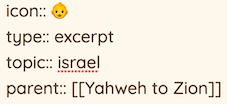This is interesting. Just as I was struggling to get a handle on Namespaces you presented this solution which makes Namespaces redundant. It comes at the right time as I have read most of a book that I have made notes on and that are subdivided into chapters.
I amended my config.edn and custom.css files, and created a custom.js file, then in a page pasted {{pagetree-to children}}, but no tree was rendered.
In the parent page I have this:
![]()
and the properties block of each child looks like this:

Could it be that the icon somehow causes a blockage, but I deleted it in 1 page thinking I would get a tree with the parent and 1 child, but nothing is rendered.